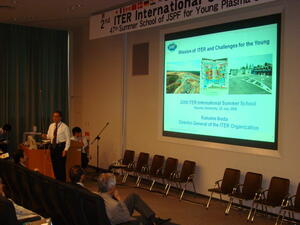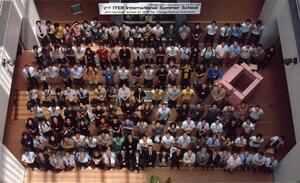More on ITER International Summer School
The 2nd ITER International Summer School, devoted to the theme of "Confinement", was hosted by the University of Kyushu, Fukuoka, Japan under the leadership of Professor S-I Itoh. The Summer School, held from 22-26 July, was attended by 132 students and 15 lecturers from 10 countries, who listened to presentations by an international group of lecturers, participated in tutorial discussions with them and presented posters on their own research.
The school was opened by a lecture from ITER Director General Kaname Ikeda, who discussed the present status of the ITER Project and emphasized the importance of training a new generation of fusion scientists and engineers in order to ensure the effective exploitation of ITER and the realization of fusion's potential for contributing to the world's energy requirements. The ITER Council secretary Sachiko Ishizaka later gave a presentation on the opportunities for working at ITER and the kind of experiences scientists and engineers coming to work at Cadarache could expect.
The majority of the summer school lectures were concerned with key scientific and technical issues relating to confinement of plasma, energy and particles that influence the design and performance of fusion devices, in particular ITER. During the tutorial sessions, smaller groups of students had the opportunity for detailed discussions with the lecturers on topics such as plasma confinement, the ITER Project etc. These sessions turned into lively exchanges between the students and "tutors".
To encourage the preparation of good quality posters, the summer school organizers made a prize available for the best poster and this was awarded on the recommendation of an international panel of lecturers from the school chaired by Professor Friedrich Wagner, currently President of the European Physical Society. The selection of the winning poster turned out to be a fairly lengthy process, due to the high quality of the research reported and the excellent level of presentation which characterized the posters.



